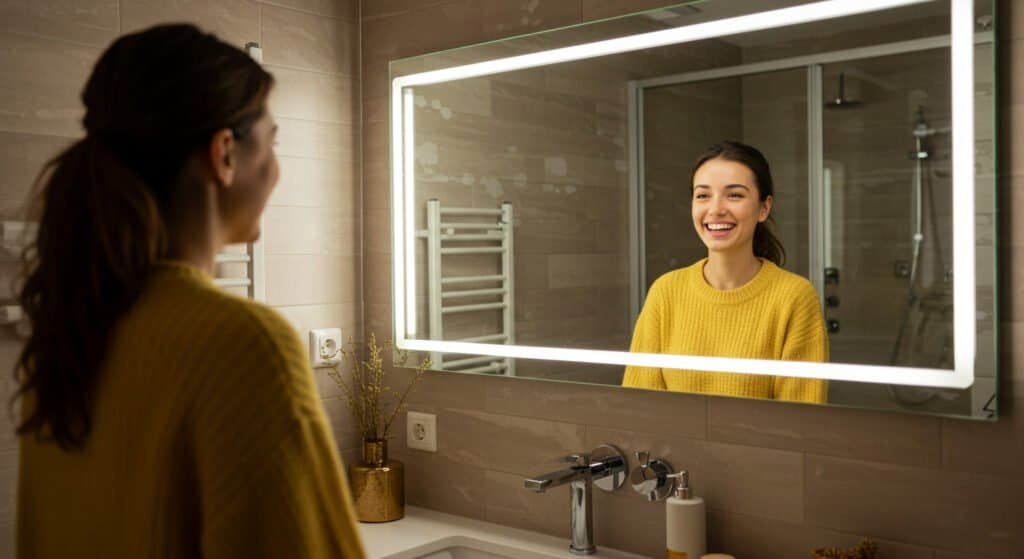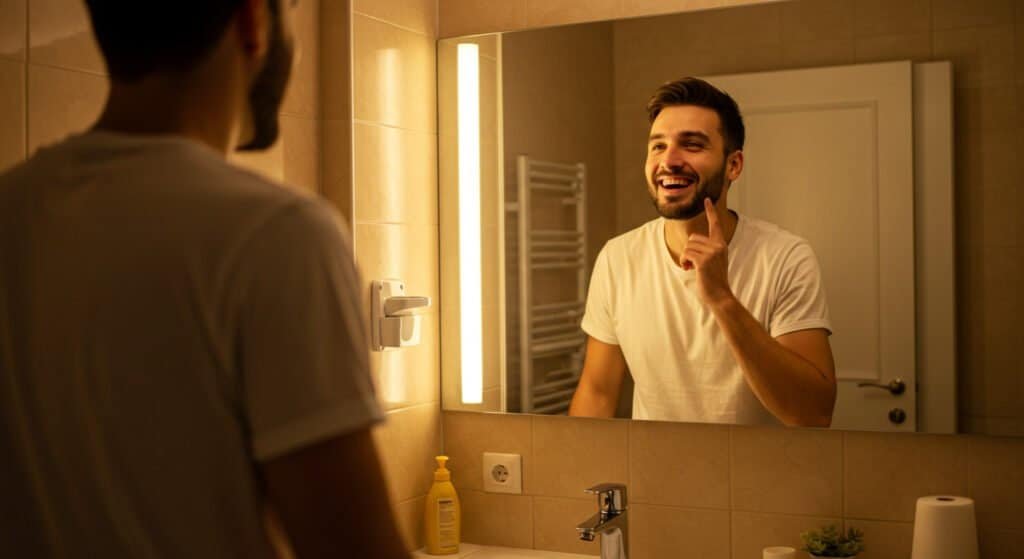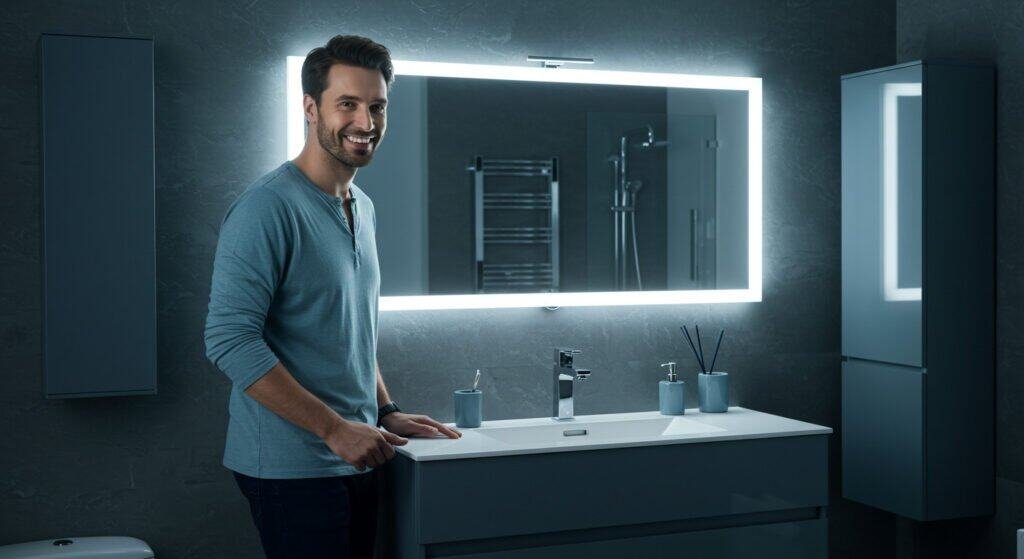Do LED Mirrors Need Electricity? This common question can lead to installation challenges and unexpected costs if overlooked. Let’s shed some light on this important consideration before your purchase.
Yes, LED mirrors definitely need electricity to function. Most led lighted mirrors connect to your home’s electrical system through hardwiring or plug-in options, though some portable models use batteries. Power requirements vary depending on features like defogging, Bluetooth capability, and lighting intensity.
Let’s explore everything you should know about powering your LED mirror to make an informed decision.

How Do LED Mirrors Work?
An LED mirror combines reflective glass with integrated Light Emitting Diode technology strategically positioned around or behind the mirror’s surface. This creates an effective illumination system that provides superior lighting compared to traditional bathroom lighting solutions.
LED mirrors work by embedding energy-efficient diodes either around the perimeter (as with light up vanity mirrors) or behind the glass (creating backlit mirrors). These diodes illuminate when electricity flows through the semiconductor material, producing bright, even light without the heat of traditional bulbs.
The most common designs include front-lit mirrors with LED strips mounted on the surface, backlit mirrors where light shines from behind creating a floating effect, and edge-lit designs where LEDs are installed along the sides. The mirror glass itself is often specially designed with anti-fog properties and sometimes includes magnification sections.
Modern led light mirror vanity options also incorporate additional features like touch sensors, dimmers, Bluetooth speakers, clock displays, and even motion sensors—all requiring careful electrical integration during manufacturing to ensure safe, reliable performance in moisture-prone bathroom environments.
Why Do LED Mirrors Require Electricity?
LED mirrors fundamentally require electrical power because the light-emitting diodes that provide illumination are electronic components that convert electrical energy into light. Without this power source, the primary lighting function that makes these mirrors so desirable simply cannot operate.
LED mirrors need electricity because their core functionality—producing light—depends on electrical current flowing through semiconductor materials in the LEDs. Additionally, premium features like defogging elements, Bluetooth speakers, and touch controls all require power to operate.
The electrical requirements stem from the basic physics of LED technology. Unlike traditional mirrors that merely reflect existing light, a led lighted mirror for bathroom actively generates illumination through its integrated LED circuit board. The current passing through the semiconductor chips creates photon emissions that produce visible light. Beyond basic lighting, most modern LED mirrors incorporate multiple power-dependent features.
The anti-fog heating elements prevent steam condensation by maintaining a higher surface temperature. Digital clocks, temperature displays, and Bluetooth audio systems each require separate circuitry and steady power. Even simple touch or wave sensors that control these features need constant low-level electricity to monitor for user input. While the actual wattage required is relatively modest compared to traditional bathroom light for mirror options, the electrical connection remains essential for functionality.

How Do LED Mirrors Get Their Power?
LED mirrors typically receive power through one of three main methods: hardwired connections to your home’s electrical system, standard plug-in cords, or battery power for certain portable models. Each power delivery method suits different installation scenarios and user needs.
Most permanent led bathroom wall mirrors connect directly to your home’s electrical wiring through a junction box, while others use standard electrical outlets with plug-in cords. Portable vanity mirrors may use rechargeable batteries or replaceable ones, offering flexibility but limited feature sets.
Hardwired installation represents the most common approach for permanent wall mirror with lights installations, creating a clean, cord-free appearance. This method requires connecting the mirror to your home’s electrical circuit through a junction box, typically at standard voltage (110-120V in the US, 220-240V in many other countries).
The second option involves plug-in models that connect to standard wall outlets, offering easier installation but leaving visible cords unless specially routed. For maximum flexibility, some manufacturers offer bathroom mirrors with built in lights powered by rechargeable lithium-ion batteries. These models provide temporary installation options or solutions for locations without accessible power sources.
Additionally, some innovative hybrid models can switch between hardwired and battery backup power, ensuring functionality during power outages. Installation complexity varies significantly between these options, with hardwired models generally requiring professional electrician services while plug-in and battery-operated versions can often be self-installed.
Can LED Mirrors Work Without Electricity?
The short answer is no—traditional LED mirrors cannot function without some form of electrical power. However, certain specialized models do offer alternative power options that might work in situations where standard electrical connections aren’t available or practical.
Standard LED mirrors won’t operate without electricity, but portable models with bathroom mirror with battery lights technology can work independently of fixed electrical connections. Some mirrors also feature solar charging capabilities or USB rechargeable batteries for temporary use away from outlets.
While conventional led lighted mirrors require electrical connections, manufacturers have developed several innovative solutions for situations where standard power isn’t available. Battery-operated LED mirrors represent the most common alternative, using replaceable batteries (typically AA or AAA) or built-in rechargeable lithium-ion batteries that can power smaller mirrors for several hours between charges.
Some premium portable models feature USB charging capabilities, allowing users to power them from laptops, power banks, or USB wall adapters. For eco-conscious consumers, certain manufacturers have introduced solar-powered vanity mirrors with small photovoltaic panels that charge internal batteries when exposed to sunlight.
It’s important to note, however, that these alternative power solutions generally support only basic lighting functions with reduced brightness and duration. Advanced features like defogging, Bluetooth connectivity, or digital displays typically require more substantial power than batteries can practically provide. For full functionality in permanent installations, traditional electrical connections remain the optimal solution.

Are LED Mirrors Energy-Efficient?
LED mirrors represent one of the most energy-efficient lighting options available for bathrooms and vanity areas. Their power-saving design provides exceptional illumination while consuming significantly less electricity than traditional lighting fixtures used with conventional mirrors.
LED mirrors are highly energy-efficient, consuming up to 80% less electricity than traditional incandescent or fluorescent bathroom light for mirror options. Their low power draw, combined with long lifespans, makes them environmentally friendly and cost-effective for daily use.
The exceptional efficiency of led lights for bathroom mirror stems from the fundamental technology behind LEDs (Light Emitting Diodes). Unlike incandescent bulbs that waste most energy as heat, LEDs convert approximately 95% of their energy input directly into light. A typical LED mirror consumes between 3-30 watts depending on size and features, compared to 60-100 watts for equivalent illumination from incandescent lighting.
This efficiency extends to all aspects of operation—even mirrors with advanced features like heated defogging elements use precisely controlled power delivery to minimize waste. The environmental benefits extend beyond daily electricity usage, as LED technology contains no hazardous materials like mercury (found in fluorescent options) and provides exceptional longevity, reducing manufacturing and disposal impacts.
For environmentally conscious consumers and those looking to reduce utility bills, the initial investment in quality LED mirror technology pays dividends through years of reduced energy consumption, often recouping the higher purchase cost within 1-3 years of regular use.
How Much Electricity Do LED Mirrors Consume?
The electricity consumption of LED mirrors varies considerably based on size, brightness settings, and additional features. However, all models offer remarkably low power requirements compared to traditional bathroom lighting solutions paired with conventional mirrors.
Most led bathroom wall mirrors consume between 3-30 watts depending on size and features. A standard 24×36-inch mirror with basic LED lighting might use only 15-20 watts, while models with heating elements, Bluetooth speakers, and digital displays could reach 40-50 watts at maximum settings.
To understand the real-world impact on electricity bills, consider that a mid-sized led lighted mirror consuming 20 watts, used for 2 hours daily, would use approximately 14.6 kilowatt-hours of electricity annually. At the US national average electricity rate of about $0.15 per kWh, this translates to roughly $2.19 per year in operating costs—remarkably economical compared to traditional lighting. Larger mirrors with multiple features naturally consume more power.
For example, a premium 48-inch bathroom mirror built in light with dimmable illumination, anti-fog heating, and Bluetooth capabilities might draw up to 45-60 watts when all features are active. However, intelligent power management in quality models means not all systems run simultaneously at full power.
Many mirrors include energy-saving features like motion sensors that activate lighting only when someone is present, automatic shutoffs after periods of inactivity, and memory functions that restore preferred settings without requiring adjustment to maximum brightness first. When comparing models, look for Energy Star certification or specific wattage ratings to identify the most efficient options that balance illumination quality with power conservation.

What Are the Pros and Cons of Lighted Mirrors?
LED mirrors offer numerous advantages over traditional mirror and lighting combinations, though they do come with certain limitations worth considering. Understanding both sides helps determine if these illuminated mirrors align with your specific needs and circumstances.
Led lighted mirrors provide superior, shadow-free illumination, space-saving design, and energy efficiency as major advantages. Potential drawbacks include higher initial cost, installation complexity for hardwired models, and dependency on electrical connections for functionality.
Among the significant advantages, wall mirrors with lights provide exceptional illumination quality with even, shadow-free lighting ideal for tasks requiring detail and precision. The integrated design saves valuable bathroom space by eliminating the need for separate vanity lights while creating a sleek, contemporary aesthetic. Energy efficiency translates to lower operating costs and reduced environmental impact.
Many models offer customizable lighting with adjustable brightness and color temperature settings, allowing personalization for different activities and preferences. The limitations begin with higher upfront costs compared to standard mirrors paired with basic lighting fixtures, though this gap narrows when comparing high-end options. LED mirror installation complexity represents another consideration, particularly for hardwired models that typically require professional electrician services, adding to the total investment.
Dependence on electricity means these mirrors lose their lighting functionality during power outages unless they incorporate battery backup systems. Additionally, while LED technology offers impressive longevity, eventual component failure might necessitate complete mirror replacement rather than simple bulb changes, though many manufacturers now design models with serviceable LED components to address this concern.
Do LED Mirrors Provide Enough Light?
LED mirrors typically provide excellent illumination that meets or exceeds the light output of traditional bathroom lighting fixtures. Their strategic LED placement creates even, shadow-free lighting ideal for detailed grooming tasks and general bathroom illumination.
Quality led light mirror vanity products deliver abundant illumination, typically producing 1000-1500 lumens or more—equivalent to traditional multi-bulb vanity fixtures. Premium models offer adjustable brightness and color temperature controls, allowing customization for different activities and personal preferences.
The effectiveness of LED mirror illumination stems from both light quantity and quality. Well-designed led lights for bathroom mirror solutions position LEDs to minimize shadows on the face—a significant advantage over overhead or side lighting. Professional-grade mirrors often achieve Color Rendering Index (CRI) ratings above 90, approaching natural sunlight’s ability to accurately display colors and skin tones.
This proves particularly important for makeup application and grooming tasks requiring color accuracy. Most quality models provide multiple lighting settings, with color temperatures ranging from warm white (2700-3000K) ideal for relaxing environments to cooler white (4000-5000K) that mimics daylight for precise grooming. For larger bathrooms, manufacturers recommend selecting mirrors with higher lumen outputs or supplementing with additional ambient lighting.
Many premium models include memory functions that restore preferred settings, ensuring consistent lighting experiences without readjustment. When evaluating light sufficiency, consider the room size, mirror dimensions, and specific activities you’ll perform—makeup professionals and those with vision impairments may benefit from higher-output models with multiple lighting zones.

Do LED Mirrors Need a Switch?
All LED mirrors require some form of control mechanism to turn the lights on and off and adjust features. While traditional wall switches can work, most modern designs incorporate more sophisticated control systems directly into the mirror itself.
LED mirrors typically feature built-in control systems rather than relying on conventional wall switches. These range from touch-sensitive panels and motion sensors to smartphone connectivity, offering intuitive operation while maintaining the mirror’s sleek aesthetic.
The control mechanisms for led lighted mirrors have evolved significantly to enhance user experience while maintaining seamless design aesthetics. Touch-sensitive controls represent the most common option, with sensors embedded either on the mirror surface or discreetly positioned along edges. These allow users to toggle power, adjust brightness, switch between lighting modes, and control additional features like Bluetooth speakers or defogging elements.
Infrared proximity sensors offer touchless operation, particularly valuable in bathroom environments where hands may be wet or when accessibility is a priority. Some premium models incorporate voice control capabilities compatible with smart home systems like Alexa or Google Home, allowing hands-free operation. For traditional installations, many manufacturers provide mirrors that can connect to standard wall switches, though this may limit functionality compared to integrated controls.
When planning your led mirror installation, consider control placement carefully—ideally positioned at a comfortable height and on the side matching your dominant hand. For homes with children or individuals with mobility limitations, mirrors with multiple control options (such as both touch and remote control) offer maximum accessibility and convenience.
How Long Do LED Mirrors Last?
LED mirrors offer exceptional longevity compared to traditional lighted mirrors using incandescent or fluorescent bulbs. Their advanced lighting technology provides years of reliable service with minimal degradation in performance when properly manufactured and maintained.
Quality led bathroom wall mirrors typically provide 30,000-50,000 hours of illumination before significant light degradation occurs. This translates to approximately 20-25 years of daily use for 3-4 hours, far outlasting traditional bulb-based lighting fixtures.
The impressive lifespan of LED mirror technology stems from several factors inherent to the LED components themselves. Unlike traditional bulbs with fragile filaments or gas tubes, LEDs are solid-state devices resistant to physical shock and vibration—important in bathroom environments where doors closing or cabinet impacts occur regularly.
Quality mirrors use LEDs rated for moisture resistance, crucial for bathroom installations where humidity levels fluctuate dramatically. The actual functional lifespan depends significantly on manufacturing quality, with premium led lighted mirror for bathroom products incorporating thermal management systems that prevent overheating, the primary cause of premature LED failure.
Additional factors affecting longevity include usage patterns and installation environment—mirrors in commercial settings with continuous operation naturally reach end-of-life sooner than residential installations with intermittent use. While the LED components typically last decades, other electronic elements like drivers, sensors, or special features might require service earlier.
Many reputable manufacturers now design mirrors with serviceable components, allowing replacement of specific elements rather than the entire unit. To maximize lifespan, choose models with aluminum heat-dissipation backing, overload protection circuitry, and moisture-resistant sealing, particularly for steam-heavy bathroom environments.

What Safety Considerations Apply to Powered LED Mirrors?
Safety remains paramount when installing electrical fixtures in moisture-prone bathroom environments. LED mirrors require specific safety features and installation considerations to ensure reliable, hazard-free operation throughout their lifespan.
Bathroom led lighted mirrors must meet strict safety standards including appropriate IP ratings for water resistance, proper electrical insulation, and compliance with bathroom zone regulations. Professional installation ensures proper grounding and connection to GFCI-protected circuits.
The primary safety consideration for any bathroom mirror built in light involves water exposure risk. Reputable manufacturers design mirrors with Ingress Protection (IP) ratings—typically IP44 or higher for bathroom use—indicating resistance to water splashes from any direction. This protection encapsulates electrical components to prevent moisture infiltration that could lead to shorts or electrical hazards.
Proper installation location significantly impacts safety, with most building codes defining specific zones within bathrooms determining what electrical fixtures can be installed where. LED mirrors should connect to Ground Fault Circuit Interrupter (GFCI) protected circuits that automatically cut power if abnormal current patterns indicate potential shock hazards.
For hardwired installations, proper grounding provides additional protection against electrical faults. Beyond electrical safety, consider physical safety aspects including secure mounting appropriate for the mirror’s weight, particularly for larger wall mirrors with lights that may exceed 50 pounds. Edge treatments also matter—quality mirrors feature polished or sealed edges to eliminate sharp glass edges.
For households with children, mirrors with overheating protection, automatic shutoff features, and finger-safe designs provide additional peace of mind. While DIY installation might seem tempting, professional electrician installation ensures compliance with local building codes and safety standards.
Do You Need an Electrician to Install LED Bathroom Mirrors?
Whether you need a professional electrician for your led mirror installation depends primarily on the power supply method and your personal electrical expertise. Different mirror types have varying installation requirements ranging from simple plug-in setups to complex hardwired configurations.
Hardwired LED bathroom mirrors typically require professional electrician installation to ensure proper connection to your home’s electrical system, code compliance, and safety. Plug-in models and battery-operated versions generally allow for DIY installation with basic tools and mounting hardware.
For hardwired led bathroom wall mirrors, professional electrician services are strongly recommended and often required by building codes. These installations involve connecting the mirror directly to your home’s electrical circuit, typically requiring access to junction boxes, proper wire routing, and potentially creating new circuits if existing ones cannot support additional fixtures.
Professional electricians ensure proper grounding, appropriate circuit protection, and compliance with local electrical codes specific to bathroom installations. They also verify that the installation meets manufacturer warranty requirements, as many companies void coverage for improperly installed products. For plug-in models, the electrical component becomes significantly simpler, though proper wall mounting remains important.
These mirrors connect to standard outlets but still require secure attachment to wall studs or appropriate anchors based on the mirror’s weight. Battery-operated bathroom mirror with battery lights offer the simplest installation, typically involving only secure mounting without electrical connections.
When deciding between professional and DIY installation, consider not only initial costs but also long-term factors including warranty protection, insurance requirements, and safety. Many homeowners insurance policies require professional installation of permanent electrical fixtures, and improperly installed mirrors could create liability issues if problems occur.

How to Choose the Right LED Mirror Based on Power Requirements?
Selecting the optimal LED mirror requires careful consideration of your specific power availability, installation preferences, and feature requirements. Understanding the electrical aspects ensures you choose a mirror that integrates seamlessly into your space while providing the functionality you desire.
Choose an LED mirror based on your power infrastructure—hardwired models for permanent installations with available electrical access, plug-in versions for locations near outlets, or battery-powered options for maximum flexibility. Consider your desired features, as advanced functions require more substantial power sources.
Begin your selection process by assessing your bathroom’s existing electrical infrastructure. If you’re replacing a hardwired light fixture above your vanity, a hardwired led lighted mirror for bathroom offers a clean installation utilizing the existing junction box.
For renovations or new constructions, discuss electrical planning with your contractor to ensure appropriate wiring placement behind the mirror location. When hardwiring isn’t possible or desired, plug-in models provide an excellent alternative but require proximity to GFCI outlets—typically within 3-6 feet depending on cord length.
Feature requirements significantly influence power selection—if you desire advanced functions like Bluetooth audio, defogging elements, or digital displays, hardwired or plug-in models deliver the consistent power these systems require. Battery-operated mirrors generally support only basic lighting without additional features and require regular battery replacement or recharging.
For larger bathrooms or primary suites, consider mirrors with higher luminosity ratings, which typically demand more substantial power connections. Finally, future-proofing deserves consideration—selecting mirrors with standard electrical connections rather than proprietary systems ensures easier service or replacement if needed. Many manufacturers now offer multiple power options for the same mirror design, allowing you to select the ideal configuration for your specific circumstances while maintaining your desired aesthetic.
Conclusion
LED mirrors definitively require electricity to deliver their signature illumination and advanced features. By understanding your power options, installation requirements, and safety considerations, you can select the perfect mirror for your space. Contact us for expert guidance.


